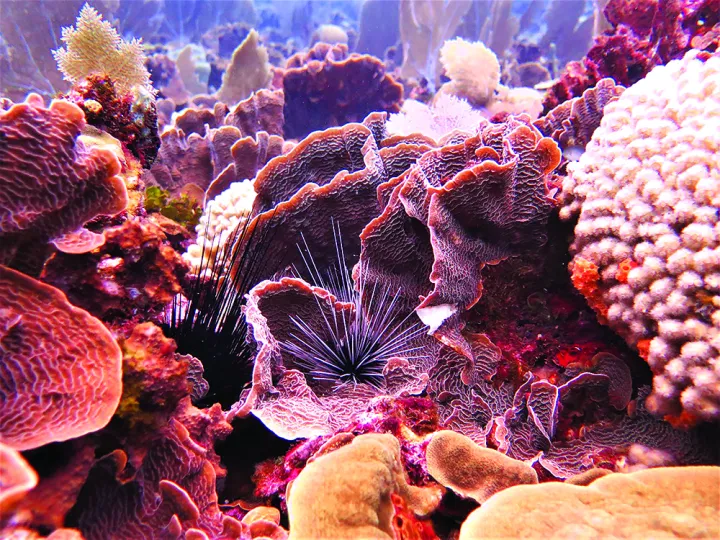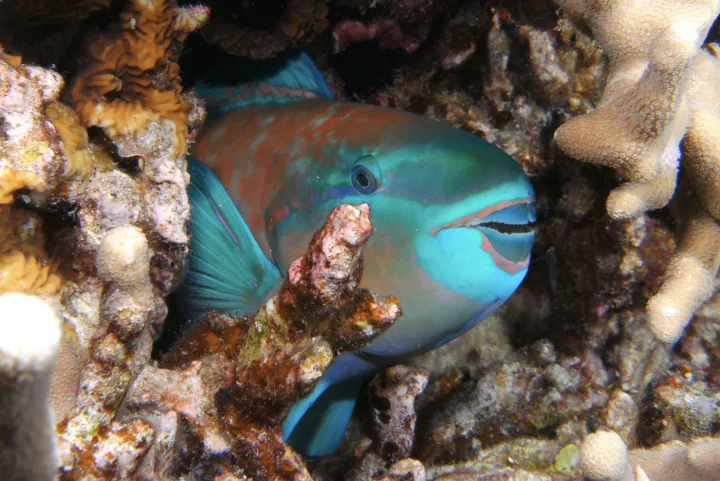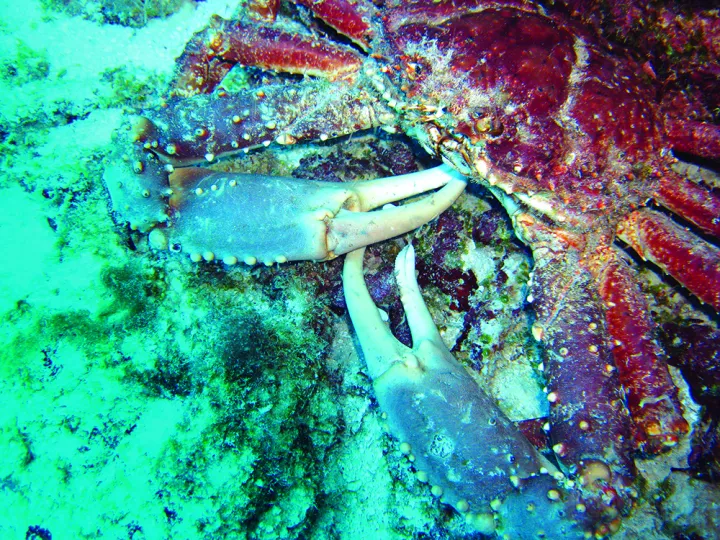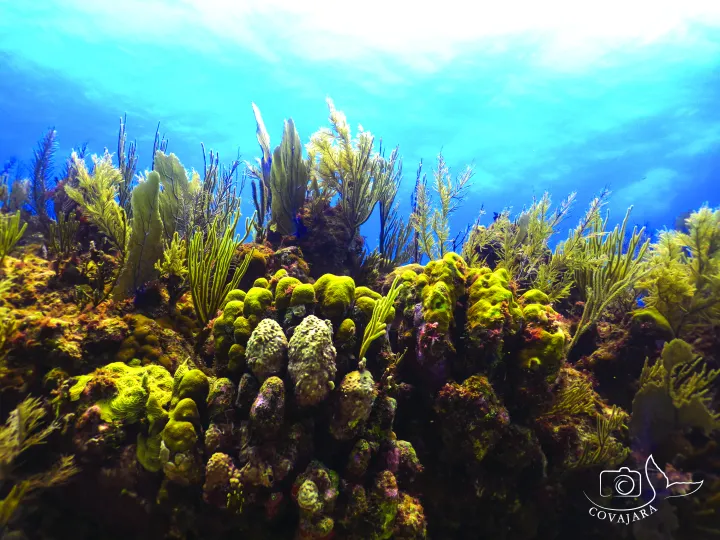Heroes of Herbivory
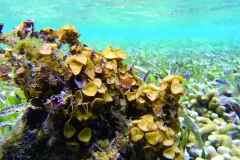
Coral restoration, often in the form of growing corals in a lab or in field-based nurseries, has become a popular response to the ongoing threats that corals face. There’s no doubt that coral restoration is crucial to bringing structure back to recovering reefs, but researchers are now also looking at different ways to support and restore critical ecological processes in these ecosystems.
Researchers with the Healthy Reefs for Healthy People Initiative (HRI) have started to focus on herbivory on the reefs in the Mesoamerican ecoregion. Herbivores who graze on the large barrier reef—which is found in the waters of Belize, Mexico, Guatemala, and Honduras—are important for keeping macroalgae growth under control. Without grazing, macroalgae can become overgrown, outcompeting corals for room on the reef.
“Take away the herbivores and the coral reef becomes an algae reef," said Melanie McField, Director of the HRI team. “We need to get more herbivores back on the reef, which we can do through management, intervention, and restoration.” The story of herbivory on the Mesoamerican reef is one of trials and triumphs, with tales of disease and die-off, in addition to overfishing, and sometimes overlooking, important marine species.
Safe Spots on the Reef
The first hero of this story is the Diadema (long-spined) sea urchin. These urchins are important herbivores who eat away at algae on reefs, however, urchin populations fell drastically after disease nearly wiped them out in the early 1980s. “This mass mortality of Diadema across the Caribbean, was one of the most significant events known in the marine realm,” said McField, “The species experienced 97 percent mortality and the loss revealed the importance of its role in controlling macroalgae.”
At the same time, Acropora (elkhorn) branching corals were struck with white band disease, which attacked the coral’s body tissues. There were enormous ecological consequences of this coral disease on the Mesoamerican reef, including for the few remaining urchins who survived the disease but lost shelter or habitat from the coral die-off.
Consequently, many of the reefs became rubble zones, and without reef structure the Diadema urchins lacked protection from predators. That's where Smithsonian scientists stepped in. A project that’s currently underway in Honduras involves researchers deploying cement “condos” to provide protection for urchins on rubble reefs. If these efforts prove successful, McField says the HRI team hopes to expand the initiative to facilitate the natural recovery of urchin populations and promote reef health throughout the region.
After almost 40 years, Diadema populations are slowly beginning to recover. Researchers believe that the ideal population density of this species is about one urchin per square meter of reef area. When this ideal density is achieved and populations are stable, there is little fleshy macroalgae and more corals. “We have a few sites on the Mesoamerican reef where we measure one urchin per meter squared and have very little macroalgae,” McField said. This confirms the need for urchin conservation efforts to promote healthy herbivory on the reef.
Protecting Plant-Eaters
While Diadema urchins are beginning to recover decades after their die-off from disease, our next herbivorous hero, parrotfish, are bouncing back after their populations were depleted from overfishing.
Historically, parrotfish were not the target of commercial fishing in the Caribbean. However, when more desirable fish for consumption, such as snapper and grouper, were fished down, the local market turned to the colorful herbivores as their food source. Soon the populations of these important grazers began to decline.
The parrotfish restoration effort has become somewhat of a straightforward success story. “There’s a fairly easy solution, you just need regulations to protect these herbivorous fish as the four Mesoamerican reef countries have now enacted,” McField noted.
Belize was the first of the four countries to protect parrotfish in 2009, with Honduras, Bay Islands following in 2010, Guatemala in 2015, and Mexico’s Quintana Roo in 2018. Once protected, the herbivorous fish populations began to increase in just a few years, although the positive effects of their grazing take some additional time. The work must be maintained, however, since these improvements can be lost rather quickly, as happened recently in Honduras due to increased poaching and lack of enforcement.
Harvesting the Solution
Our story’s final hero is the Caribbean king crab, a species that had been largely overlooked as an important herbivore. It is unclear if the king crab’s low population density is natural or due to overfishing and habitat loss, as this species was also affected by the coral die-off in the 1980s.
The HRI team is working to better understand the potential beneficial role of the Caribbean king crab on reef herbivory, as the crabs may reduce macroalgae cover at an even greater rate than parrotfish. Putting the crabs to the test, HRI researchers experimented with transplanting adult king crabs onto protected reefs in the region. What they found was a decrease in macroalgae over time and, most importantly, an increase in coralline algae—a substrate that promotes coral growth.
The team has also found that the crabs have good potential for aquaculture growth as they reproduce all year. McField explains that with proper regulations, a commercially valuable fishery could be established.
Currently, the HRI team is working to develop sustainable, small-scale mariculture systems in Mexico and Belize. About 50 juvenile king crabs are almost ready to be returned to natural reefs, where they’ll live out the rest of their lives, dining on abundant fleshy macroalgae.
“These small young crabs will feed voraciously,” McField said. “Then when they get to market size, the ones that are in the open fishing areas can be fished and the ones that are in the protected zones of the marine protected areas will stay and grow and make those areas even more healthy.”
Researchers anticipate that this system will not only promote healthy king crab populations and grazing at these sites, but also support local economies via the fishery.
Bringing It All Together
Restoring reef ecosystems is a challenge that requires different research approaches. With these multi-pronged efforts to restore herbivory along with coral restoration efforts, and reduction of nutrient pollution, researchers are beginning to build a better picture of what it takes to reestablish both physical structure and ecological processes on the reef.
Every two years, HRI releases a report card on the health of the Mesoamerican reef. As the Caribbean king crab, parrotfish, and Diadema sea urchin continue to improve reef health, researchers hope to see the efforts of these herbivorous heroes in the form of improving report card grades over the next few years.


